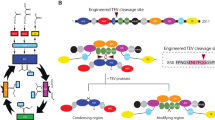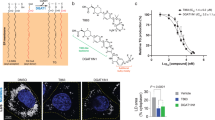Abstract
Human fatty acid synthase (FAS) is uniquely expressed at high levels in many tumor types. Pharmacological inhibition of FAS therefore represents an important therapeutic opportunity. The drug Orlistat, which has been approved by the US Food and Drug Administration, inhibits FAS, induces tumor cell–specific apoptosis and inhibits the growth of prostate tumor xenografts. We determined the 2.3-Å-resolution crystal structure of the thioesterase domain of FAS inhibited by Orlistat. Orlistat was captured in the active sites of two thioesterase molecules as a stable acyl-enzyme intermediate and as the hydrolyzed product. The details of these interactions reveal the molecular basis for inhibition and suggest a mechanism for acyl-chain length discrimination during the FAS catalytic cycle. Our findings provide a foundation for the development of new cancer drugs that target FAS.
This is a preview of subscription content, access via your institution
Access options
Subscribe to this journal
Receive 12 print issues and online access
$189.00 per year
only $15.75 per issue
Buy this article
- Purchase on Springer Link
- Instant access to full article PDF
Prices may be subject to local taxes which are calculated during checkout




Similar content being viewed by others
References
Kuhajda, F.P. Fatty acid synthase and cancer: new application of an old pathway. Cancer Res. 66, 5977–5980 (2006).
Kuhajda, F.P. et al. Synthesis and antitumor activity of an inhibitor of fatty acid synthase. Proc. Natl. Acad. Sci. USA 97, 3450–3454 (2000).
Pizer, E.S. et al. Inhibition of fatty acid synthesis delays disease progression in a xenograft model of ovarian cancer. Cancer Res. 56, 1189–1193 (1996).
Pizer, E.S. et al. Increased fatty acid synthase as a therapeutic target in androgen-independent prostate cancer progression. Prostate 47, 102–110 (2001).
Alli, P.M., Pinn, M.L., Jaffee, E.M., McFadden, J.M. & Kuhajda, F.P. Fatty acid synthase inhibitors are chemopreventive for mammary cancer in neu-N transgenic mice. Oncogene 24, 39–46 (2005).
De Schrijver, E., Brusselmans, K., Heyns, W., Verhoeven, G. & Swinnen, J.V. RNA interference-mediated silencing of the fatty acid synthase gene attenuates growth and induces morphological changes and apoptosis of LNCaP prostate cancer cells. Cancer Res. 63, 3799–3804 (2003).
Kridel, S.J., Axelrod, F., Rozenkrantz, N. & Smith, J.W. Orlistat is a novel inhibitor of fatty acid synthase with antitumor activity. Cancer Res. 64, 2070–2075 (2004).
Browne, C.D., Hindmarsh, E.J. & Smith, J.W. Inhibition of endothelial cell proliferation and angiogenesis by orlistat, a fatty acid synthase inhibitor. FASEB J. 20, 2027–2035 (2006).
Little, J.L., Wheeler, F.B., Fels, D., Koumenis, C. & Kridel, S.J. Fatty acid synthase inhibitors induce endoplasmic reticulum stress in tumor cells. Cancer Res. 67, 1262–1269 (2007).
Chirala, S.S. & Wakil, S.J. Structure and function of animal fatty acid synthase. Lipids 39, 1045–1053 (2004).
Smith, S., Witkowski, A. & Joshi, A.K. Structural and functional organization of the animal fatty acid synthase. Prog. Lipid Res. 42, 289–317 (2003).
Pazirandeh, M., Chirala, S.S., Huang, W.Y. & Wakil, S.J. Characterization of recombinant thioesterase and acyl carrier protein domains of chicken fatty acid synthase expressed in Escherichia coli. J. Biol. Chem. 264, 18195–18201 (1989).
Lin, C.Y. & Smith, S. Properties of the thioesterase component obtained by limited trypsinization of the fatty acid synthetase multienzyme complex. J. Biol. Chem. 253, 1954–1962 (1978).
Joshi, A.K., Witkowski, A., Berman, H.A., Zhang, L. & Smith, S. Effect of modification of the length and flexibility of the acyl carrier protein-thioesterase interdomain linker on functionality of the animal fatty acid synthase. Biochemistry 44, 4100–4107 (2005).
Singh, N., Wakil, S.J. & Stoops, J.K. On the question of half- or full-site reactivity of animal fatty acid synthetase. J. Biol. Chem. 259, 3605–3611 (1984).
Asturias, F.J. et al. Structure and molecular organization of mammalian fatty acid synthase. Nat. Struct. Mol. Biol. 12, 225–232 (2005).
Brink, J. et al. Experimental verification of conformational variation of human fatty acid synthase as predicted by normal mode analysis. Structure 12, 185–191 (2004).
Maier, T., Jenni, S. & Ban, N. Architecture of mammalian fatty acid synthase at 4.5 Å resolution. Science 311, 1258–1262 (2006).
Chakravarty, B., Gu, Z., Chirala, S.S., Wakil, S.J. & Quiocho, F.A. Human fatty acid synthase: structure and substrate selectivity of the thioesterase domain. Proc. Natl. Acad. Sci. USA 101, 15567–15572 (2004).
Hadvary, P., Sidler, W., Meister, W., Vetter, W. & Wolfer, H. The lipase inhibitor tetrahydrolipstatin binds covalently to the putative active site serine of pancreatic lipase. J. Biol. Chem. 266, 2021–2027 (1991).
Luthi-Peng, Q., Marki, H.P. & Hadvary, P. Identification of the active-site serine in human pancreatic lipase by chemical modification with tetrahydrolipstatin. FEBS Lett. 299, 111–115 (1992).
Ma, G. et al. Total synthesis and comparative analysis of orlistat, valilactone, and a transposed orlistat derivative: inhibitors of fatty acid synthase. Org. Lett. 8, 4497–4500 (2006).
Purohit, V.C., Richardson, R.D., Smith, J.W. & Romo, D. Practical, catalytic, asymmetric synthesis of beta-lactones via a sequential ketene dimerization/hydrogenation process: inhibitors of the thioesterase domain of fatty acid synthase. J. Org. Chem. 71, 4549–4558 (2006).
Nardini, M. & Dijkstra, B.W. Alpha/beta hydrolase fold enzymes: the family keeps growing. Curr. Opin. Struct. Biol. 9, 732–737 (1999).
Kraut, J. Serine proteases: structure and mechanism of catalysis. Annu. Rev. Biochem. 46, 331–358 (1977).
Pflugrath, J.W. The finer things in X-ray diffraction data collection. Acta Crystallogr. D Biol. Crystallogr. 55, 1718–1725 (1999).
McCoy, A.J., Grosse-Kunstleve, R.W., Storoni, L.C. & Read, R.J. Likelihood-enhanced fast translation functions. Acta Crystallogr. D Biol. Crystallogr. 61, 458–464 (2005).
Emsley, P. & Cowtan, K. Coot: model-building tools for molecular graphics. Acta Crystallogr. D Biol. Crystallogr. 60, 2126–2132 (2004).
Brunger, A.T. et al. Crystallography & NMR system: a new software suite for macromolecular structure determination. Acta Crystallogr. D Biol. Crystallogr. 54, 905–921 (1998).
Murshudov, G.N., Vagin, A.A. & Dodson, E.J. Refinement of macromolecular structures by the maximum-likelihood method. Acta Crystallogr. D Biol. Crystallogr. 53, 240–255 (1997).
Kleywegt, G.J. Crystallographic refinement of ligand complexes. Acta Crystallogr. D Biol. Crystallogr. 63, 94–100 (2007).
Schuttelkopf, A.W. & van Aalten, D.M. PRODRG: a tool for high-throughput crystallography of protein-ligand complexes. Acta Crystallogr. D Biol. Crystallogr. 60, 1355–1363 (2004).
Davis, I.W., Murray, L.W., Richardson, J.S. & Richardson, D.C. MOLPROBITY: structure validation and all-atom contact analysis for nucleic acids and their complexes. Nucleic Acids Res. 32, 615–619 (2004).
Collaborative Computational Project, Number 4. The CCP4 suite: programs for protein crystallography. Acta Crystallogr. D Biol. Crystallogr. 50, 760–763 (1994).
Binkowski, T.A., Naghibzadeh, S. & Liang, J. CASTp: computed atlas of surface topography of proteins. Nucleic Acids Res. 31, 3352–3355 (2003).
DeLano, W.L. The PyMOL Molecular Graphics System (DeLano Scientific, San Carlos, California, USA, 2002).
Acknowledgements
This work was supported by developmental funds from Wake Forest University School of Medicine, the Kulynych Interdisciplinary Cancer Research Fund, the US Department of Defense Prostrate Cancer Research Program (W81XWH-05-1-0065) and the US National Institutes of Health, National Cancer Institute (R01 CA114104) to S.J.K and W.T.L. The authors' views and opinions do not reflect those of the US Army or the Department of Defense. The authors thank T. Hollis and D.A. Lehtinen for assistance in collecting diffraction data on beamline x12c at the National Synchrotron Light Source, Brookhaven National Laboratory. The National Synchrotron Light Source is supported by funds from the US Department of Energy, Office of Science, Office of Basic Energy Sciences under contract no. DE-AC02-98CH10886. We also thank J.D. Schmitt for insightful discussions and comments on the manuscript.
Author information
Authors and Affiliations
Contributions
C.W.P., S.J.K. and W.T.L. designed the experiments and interpreted the structure; S.J.K. generated the expression clone; C.W.P. and L.C.J. performed all protein expression, purification and crystallization; C.W.P. and W.T.L. contributed to structure solution and refinement; all authors contributed to manuscript preparation.
Corresponding author
Ethics declarations
Competing interests
The authors declare no competing financial interests.
Supplementary information
Supplementary Text and Figures
Supplementary Figures 1–3 (PDF 673 kb)
Rights and permissions
About this article
Cite this article
Pemble, C., Johnson, L., Kridel, S. et al. Crystal structure of the thioesterase domain of human fatty acid synthase inhibited by Orlistat. Nat Struct Mol Biol 14, 704–709 (2007). https://doi.org/10.1038/nsmb1265
Received:
Accepted:
Published:
Issue Date:
DOI: https://doi.org/10.1038/nsmb1265
This article is cited by
-
Tyrosine-targeted covalent inhibition of a tRNA synthetase aided by zinc ion
Communications Biology (2023)
-
Discovery and biosynthetic pathway analysis of cyclopentane–β-lactone globilactone A
Nature Synthesis (2023)
-
Posttranslational control of lipogenesis in the tumor microenvironment
Journal of Hematology & Oncology (2022)
-
Metabolomic credentialing of murine carcinogen-induced urothelial cancer
Scientific Reports (2021)
-
Evaluation of the antiviral activity of orlistat (tetrahydrolipstatin) against dengue virus, Japanese encephalitis virus, Zika virus and chikungunya virus
Scientific Reports (2020)



